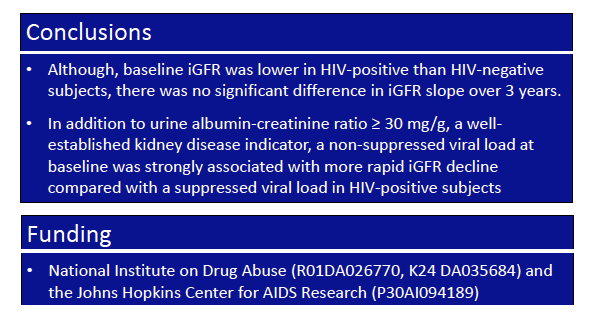 |
 |
 |
| |
Traditional and Viral Factors Associated With Iohexol-Based GFR Slope Over 3 Years
|
| |
| |
Reported by Jules Levin
CROI 2016

Author(s):
Gregory M. Lucas1; Mohamed G. Atta1; Katie Zook1; Allison M. McFall1; Shruti H. Mehta1; Derek M. Fine1; James H. Stein2; George J. Schwartz3
1Johns Hopkins Univ, Baltimore, MD, USA;2Univ of Wisconsin-Madison, Madison, WI, USA;3Univ of Rochester, Rochester, NY, USA
Abstract Body:
Monitoring kidney function is important in HIV-positive persons, but creatinine-based estimates of glomerular filtration rate (GFR) have limitations. There are little to no data assessing longitudinal GFR trends in HIV-positive persons using a gold-standard measure of GFR.
We measured GFR based on iohexol plasma disappearance (iGFR) annually for 3 years in non-diabetic, HIV-positive and HIV-negative volunteers with normal estimated kidney function. Additionally, we measured carotid intima-media thickness and pulse wave velocity at baseline. We used mixed linear models to evaluate factors associated with baseline iGFR and iGFR slope.
191 HIV-positive and 100 HIV-negative, predominantly black individuals (median age 49 years) participated in the study and completed a median (IQR) of 4 (3, 4) annual iGFR assessments. The average baseline iGFR values were lower in HIV-positive compared with HIV-negative participants (103.2 vs. 110.8, mL/min/1.73m2, P=0.004), despite similar estimated GFR by the CKD-EPI equation (average eGFR, 101 mL/min/1.73m2 in both groups). Subsequent iGFR decline was not significantly different in HIV-positive and HIV-negative subjects (iGFR slope, -1.94 vs. -3.28 mL/min/1.73m2 per year, respectively, P=0.092). In the HIV-positive group, lower baseline iGFR values were significantly associated with the presence of carotid plaque (98.3 vs. 109.4 mL/min/1.73m2, P<0.001) and hepatitis C virus coinfection (100.0 vs. 107.1 mL/min/1.73m2, P=0.024). A non-suppressed HIV RNA level at baseline was associated with a significantly more rapid iGFR decline compared with individuals with HIV RNA < 400 copies/mL (-4.69 vs. -1.31 mL/min/1.73m2 per year, P=0.005). Other factors significantly associated with iGFR slope in HIV-positive participants included albuminuria and glycosylated hemoglobin. Increased pulse wave velocity, a measure of vascular stiffness, had a near statistically significant association with more rapid iGFR decline.
Despite similar estimated GFR in the two groups, HIV-positive participants had significantly lower baseline iGFR than HIV-negative participants. Subsequent 3-year iGFR slope was similar in the two groups. Among HIV-positive subjects, hepatitis C coinfection was associated with a lower baseline iGFR and a non-suppressed HIV RNA at baseline was strongly associated with a more rapid iGFR decline.



|
| |
|
 |
 |
|
|